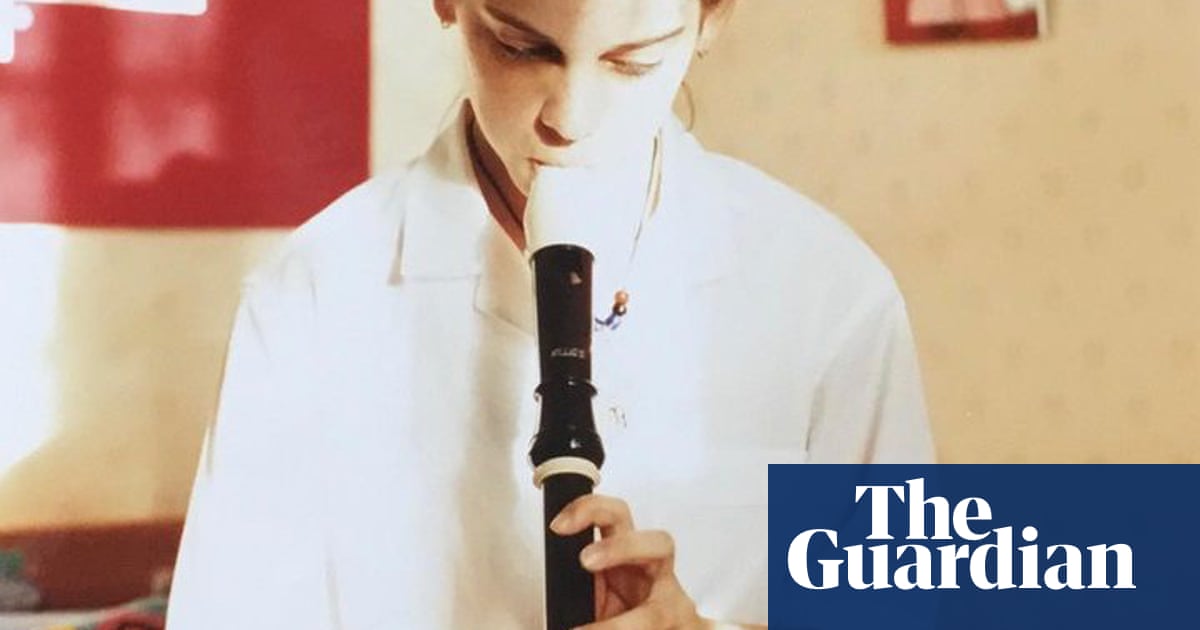
he man in a waistcoat and jeans stands over a woman who lies face-down on a vinyl bed. He is all hairy arms, and she a mop of dip-dyed hair. He presses one palm on her back; with the other he cups the side of her head and sharply thrusts. Click, crack: her neck twists in a way that necks don’t usually like to be twisted. The woman curses in apparent relief; the man laughs. He is Joseph Cipriano, a chiropractor who is also known as Dr Joe Back Crack or the Y Strap Doc (after his trademark treatment tool) and this video of him adjusting a client with “*EXTREMELY LOUD* chiropractic cracking” has been viewed 19m times.
Cipriano, who has 1.6 million subscribers on YouTube and his own range of “Team Y Strap” and “Make Your Spine Great Again” sweatshirts, is one of what his fellow chiropractors, Doc Manasseh, calls “a new wave of chiropractors globally to have gone viral”. In an age of back pain, chiropractors are the new social media influencers. But why do so many people want to watch them? And is the rise about more than a interest in good spine health?
Cipriano is an unlikely figure. Before retraining in chiropractic at Life University in Marietta, Georgia, he worked in construction with his father. Together, they “would take homes that needed remodelling and we would remodel the house, flip them and sell them”. It was his father who urged him to change careers after losing “millions” in 2008’s recession. “You’ve got to do something in the medical field. When a depression happens again, you won’t be affected,” Cipriano Sr advised. Maybe chiropractic isn’t so very different to construction – now Cipriano is flipping not buildings, but people.
That term “medical” is not quite right, of course, as chiropractic is a complementary and alternative form of therapy, and although a degree and postgraduate qualification are required, it remains a contentious form of healthcare. As a profession, chiropractic has had its run-ins with science (until 1983, the American Medical Association considered chiropractic “an unscientific cult”), no doubt helped by the fact that its founder, Daniel David Palmer, referred to it as a religion and argued that chiropractors were a conduit for divine intervention in human ill health. The NHS website states that there’s little evidence that it can help with anything other than relieving pain in muscles or joints and says: “If you need a hands-on treatment, a GP is more likely to refer you to a physiotherapist.”
It was Cipriano’s sister and her husband, a digital marketing expert in the automotive industry, who, in 2018, came up with the idea of posting treatment videos on social media.
“I laughed at them,” Cipriano says, speaking on the phone from Greenville, North Carolina where he practises. “I was like, ‘Nobody wants to see me. Come on!’” But his brother-in-law was “pulling up numbers, showing me stats of a few other YouTube chiropractors. ‘Look at all the exposure, the marketing.’” So, Cipriano began to take his chiropractic table with him to family picnics and friends’ houses. He would adjust a willing patient while his wife – AKA Mama Cip, who now has her own YouTube channel – filmed it all on her iPhone.
Things have moved on since those days. The Ciprianos use a Rode shotgun microphone attached to a camera to pick up the cracks and clicks with maximum clarity, and clients are offered a 50% discount if they give permission for the session to be recorded and shared on public platforms, halving the cost of a $200 treatment. All Cipriano’s clients come through Facebook and YouTube. “When people come in, they’re like, ‘Oh my gosh, I feel like I am meeting a celebrity!’” he says. Fully booked till next June, Cipriano is working so hard that he has a bad back himself from being bent over his chiropractic table all day long.
So why does Cipriano think people are queueing up for his services, and pleading with him to post the videos on YouTube?
“How I dress, and how I act with patients is very down to earth,” he says. He often wears ripped jeans, a T-shirt and trainers. “The majority of my viewers are aged 25 to 35, and I’m 33. So I appeal to that age group. I build a rapport with people.”
But there is another reason. Far from the pandemic having the impact on his business that the recession had on his father’s, Cipriano’s practice has boomed. “I’ve been getting a lot of patients coming in that used to work in an office and now they’ve been working from home. They don’t have a good set-up, sitting on the couch …” Covid-19, he says, among its other consequences, has been very bad for people’s backs.
“Patients are realising that the set-ups they have at home have not been conducive to back health,” agrees Catherine Quinn, the president of the British Chiropractic Association (BCA). Quinn practises in Bristol as well as providing chiropractic care to Queens Park Rangers football club. She has never posted a cracking video herself; she wouldn’t feel comfortable “asking a patient if they were OK with me doing that”, she says. But she is worried about research that the BCA has just carried out that shows that back pain is indeed becoming more widespread as a result of lockdown. Surprisingly, it is young people who have been hit hardest. According to the BCA’s survey of 10,000 people in Britain, 18-24-year-olds have experienced more symptoms of back pain since March than the over-55s.
Back pain is only a small part of the appeal of chiropractic influencers. “The obsession with watching these videos, it has nothing to do with what chiropractic really does,” says Chris Zaino. The Texas-based chiropractor trained Cipriano and introduced him to the legendary Y strap – a sinister-looking strap that is fitted under the chin to sharply tug the head away from the body (and which does not feature in chiropractic training in the UK). “They like to see people or hear people, let’s face it, getting their neck cracked or their back cracked. It’s all about that cracking noise.”
“The louder the better for me,” says Cody Hanish, AKA Dr Cody, a chiropractor based in Sydney who has amassed 2.5 million followers on TikTok. Even after 11 years of practice, “I get super-excited. Haven’t lost that drive to hear yet another crack,” he says. He has always wanted “a really good DJ to mix a really cool song with the cracks. That would be the best song ever.”
His favourite adjustment to perform is at “the CT junction”, the cervicothoracic junction – basically the meeting point of the neck and the back. “You push against the spinous process [the bumps you feel on your spine] and give some rotation, bring the hip in the opposite direction, and it locks up beautifully,” he enthuses. “And then when you give the thrust, it is usually fireworks that go off. It is super-loud.” Hanish says that smaller bodies, especially those of petite women, make the loudest noises as there is less fat to muffle the sounds.
Cracking videos are often tagged as ASMR, and superficially may resemble the genre, so-called because the videos can trigger an autonomous sensory meridian response, a brain tingling, often from audio of hair-brushing, tapping or whispering. But according to Giulia Poerio, a lecturer in psychology at the university of Essex and the lead researcher on a study of ASMR, chiropractic videos are actually at odds with this category. “Because the sounds and movement are not soft and delicate,” she says. “It’s almost the opposite of ASMR.”
However, Poerio does see an “emotional complexity” in the cracking videos that does recall ASMR. Watching Hanish’s cracking posts on TikTok, Poerio says, she was struck by “the unanticipated nature of that sound coming. It’s quite shocking … The same as watching a horror movie, but really enjoying it even though you’re absolutely terrified.” After all, some patients, have died after a chiropractic adjustment.
In the UK, there is no system to monitor the occurrence of complications or deaths following treatment, but high-profile cases – such as that of a retired bank manager who suffered spinal injuries on a chiropractic table in York and later died, or the 34-year-old model Katie May, who died from a stroke following a chiropractic manipulation in 2016 – are reported. However, the NHS advises that “chiropractic is generally safe when performed correctly by a trained and registered chiropractor”.
“There is a bit of a scare factor,” in the videos, Hanish agrees. “It sounds like it should be painful, but it’s the opposite of that. I think the appeal is probably a combination of being totally shit-scared, and then, when it [the adjustment] does happen, laughter ensues.”
Hanish’s waiting room is decorated (by his partner, an interior designer) to resemble “Tom Ford’s living room”. It is stylish and sexy, and plenty of people in comments have compared chiropractic videos – which, after all, relentlessly show compliant bodies responding to manipulation with ecstasy – to pornography. Hanish disagrees. “That is what they are associating with it. Nothing sexual goes through my mind. My focus is to help a person who is in pain.”
One thing is certain: all cracking videos follow the same narrative trajectory. A person enters the room carrying pain, and leaves with relief. Hanish reports that many people who watch his videos later get in touch to say they have experienced pain relief themselves. But for those who lack the empathy and imagination required to experience pain relief vicariously, there is still the reward of witnessing another person’s condensed, consumable, emotional journey. During the pandemic, Poerio, the psychologist, says, people “are looking for more stimulation”. She points out that views of ASMR videoes rose by 22% in the UK during the first lockdown. “It might be that there’s a need to flex your emotional muscles. Because if you’re not interacting with people, you might be motivated to seek that diversity of emotional experience through other forms.”
Cipriano says that the first time he experienced the Y strap adjustment, “all the stress and tension that was built up … with one pull of that strap, the entire spine was decompressed. Everything felt light.” Whatever the efficacy or otherwise of chiropractic treatment, it is clear that cracking videos do have something to offer. Maybe, as Cipriano puts it, like the Y strap, they simply provide “a complete pressure release”.












